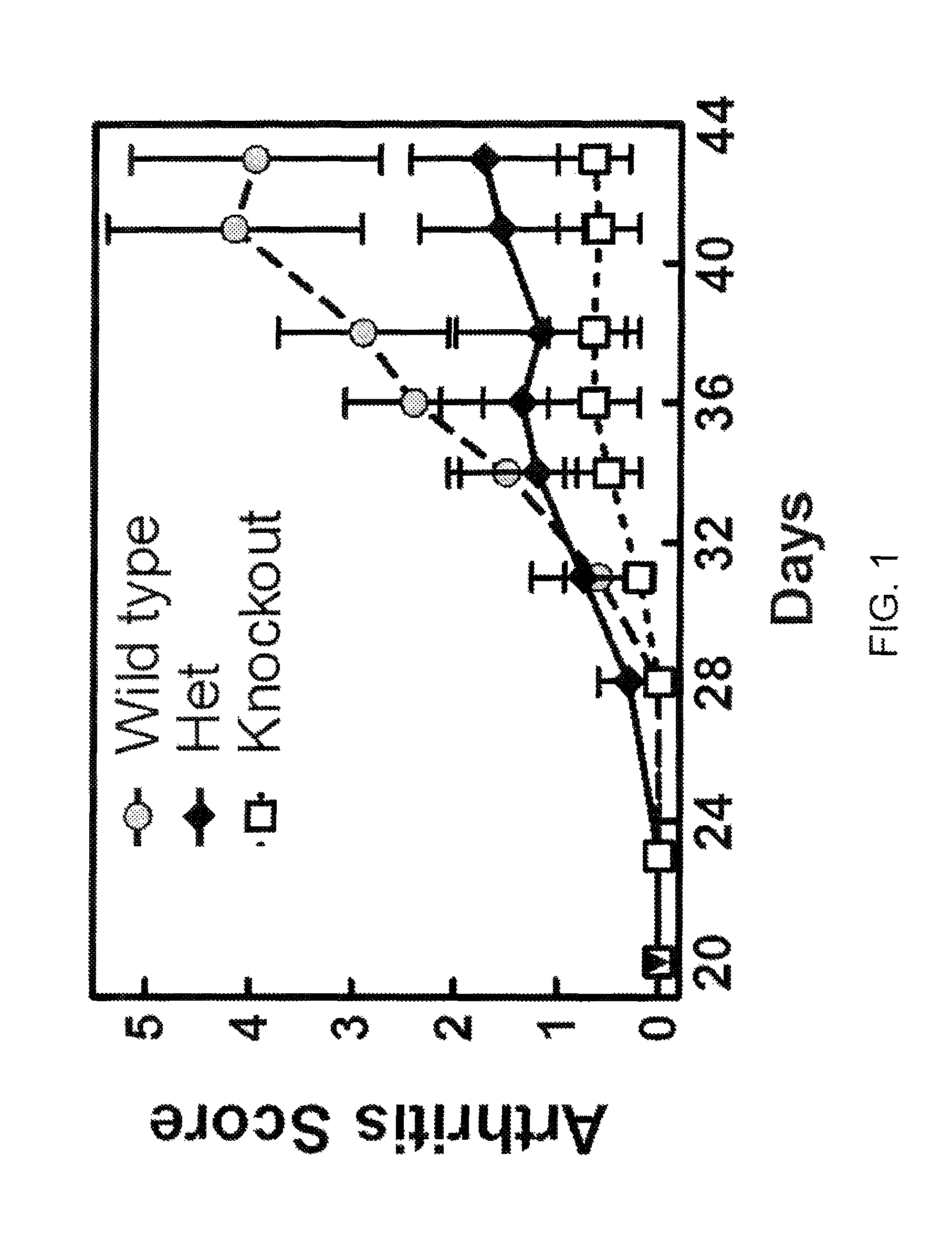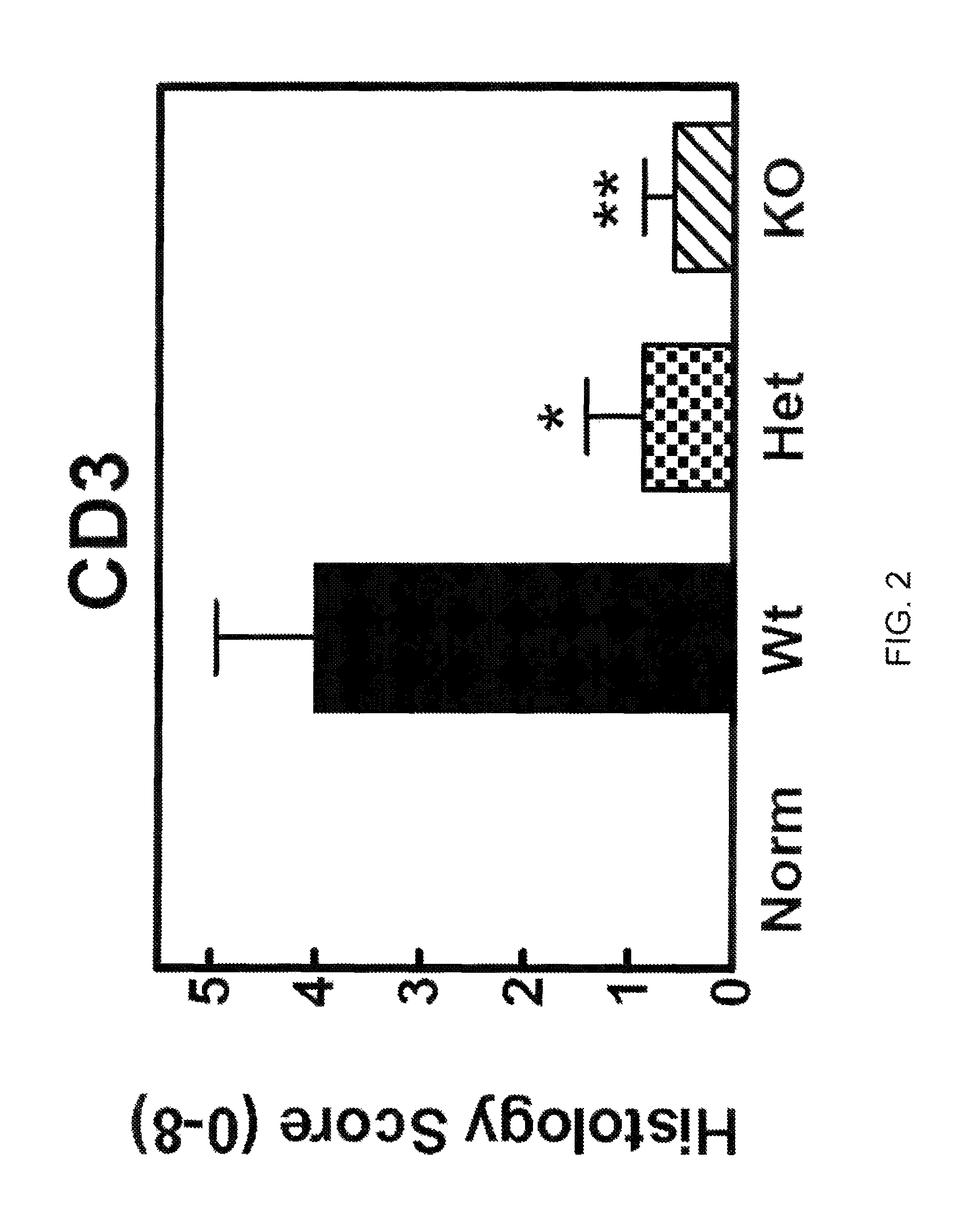Neutralizing anti-CCL20 antibodies
a technology of anti-ccl20 and neutralizing antibodies, which is applied in the field of humanized, chimeric and murine antibodies, can solve problems such as negative consequences, and achieve the effects of reducing human ccl20-induced chemotaxis
- Summary
- Abstract
- Description
- Claims
- Application Information
AI Technical Summary
Benefits of technology
Problems solved by technology
Method used
Image
Examples
example 1
Involvement of CCL20 in Autoimmune / Inflammatory Disorders
[0527]To obtain evidence for the involvement of CCL20 in autoimmune and inflammatory conditions, we studied the effects of knocking out the CCL20 receptor CCR6 in a type II collagen-induced arthritis (CIA) mouse rheumatoid arthritis (RA) model. CCR6 wild type mice, CCR6+ / − (heterozygous) mice, and CCR6− / − (homozygous) knock-out mice (each n=10) were immunized at the base of the tail with bovine type II collagen (150 μg / mouse) emulsified in complete Freund's adjuvant (Chondrex, #7001). Three weeks later, a booster injection of the same amount of bovine type H collagen emulsion in incomplete adjuvant was administered at the base of the tail. We graded the severity of arthritic symptoms in the paws of each mouse as described in Griswold et al., Arthritis &Rheumatism 31(11):1406-1412 (1988). Briefly, we graded the articular lesions of the extremities distal to the elbow or knee on a scale of 0 to 4 based on the number of joints in...
example 2
Inhibition of CCL20-Induced Chemotaxis by Hamster Anti-Mouse CCL20 2F5-5 MAb
[0531]To further explore the role of CCL20 as a potential therapeutic target, we performed experiments using a hamster anti-mouse CCL20 antibody (2F5-5). We first characterized the ability of the 2F5-5 MAb to bind to mouse, human, and rhesus CCL20. Soluble CCL20-secreted alkaline phosphatase (SEAP) antigens of each species were prepared as follows. The cDNAs encoding the CCL20s of human, cynomolgus monkey, rhesus monkey, rat, and mouse were amplified and subcloned into a pcDNA3.1 (+) dSalI SEAP vector, which contains SEAP cDNA and has its SalI site deleted (pcDNA 3.1 (+) purchased from Invitrogen; SEAP cDNA derived from a pSEAP-Enhancer vector, Clontech). The expression vectors were transfected into the human embryo kidney cell line HEK293EBNA (HEK293E, Invitrogen). The HEK293E cells were inoculated with DMEM (Invitrogen) supplemented with 10% fetal bovine serum on the day before transfection. On the day of ...
example 3
Humanization of Mouse Anti-CCL20 MAbs
[0535]To obtain monoclonal antibodies against human CCL20, we generated a panel of mouse anti-human CCL20 antibodies. Recombinant human CCL20 (R&D, #360-MP-025 / CF, 17.5 μg / head) emulsified with Freund's complete adjuvant (Mitsubishi-Kagaku Yatron, RM606-1) was injected subcutaneously into the footpads of the mice. Two consecutive injections were then administered every three days. Three days after the final immunization, the animals were sacrificed and the inguinal lymph-node cells were fused with P3U1 myeloma cells at a 2:1 to 10:1 ratio in the presence of 50% polyethylene glycol. The cells were then cultured in 96-well plastic plates.
[0536]Sandwich ELISA was used for primary screening. A 96-well plate was coated with a polyclonal anti-human IgG antibody (Jackson, #709-005-149, 2 μg / ml in PBS (−)). After overnight incubation at 4° C., the wells were blocked with 1×Block-Ace (Dainippon Sumitomo Pharma, UK-B80) for 1 hour at room temperature. The ...
PUM
| Property | Measurement | Unit |
|---|---|---|
| flow rate | aaaaa | aaaaa |
| temperature | aaaaa | aaaaa |
| concentration | aaaaa | aaaaa |
Abstract
Description
Claims
Application Information
 Login to View More
Login to View More - R&D
- Intellectual Property
- Life Sciences
- Materials
- Tech Scout
- Unparalleled Data Quality
- Higher Quality Content
- 60% Fewer Hallucinations
Browse by: Latest US Patents, China's latest patents, Technical Efficacy Thesaurus, Application Domain, Technology Topic, Popular Technical Reports.
© 2025 PatSnap. All rights reserved.Legal|Privacy policy|Modern Slavery Act Transparency Statement|Sitemap|About US| Contact US: help@patsnap.com



